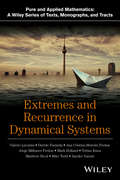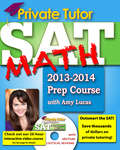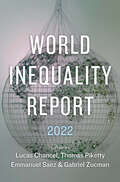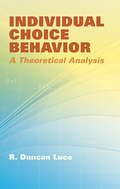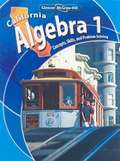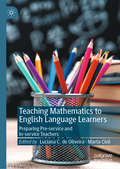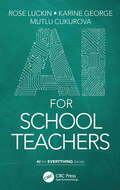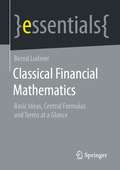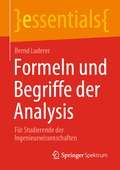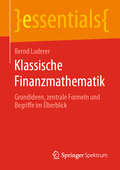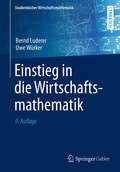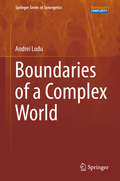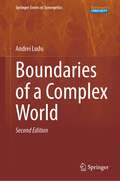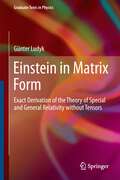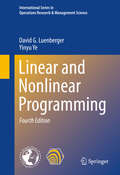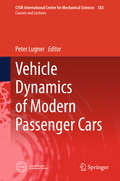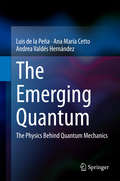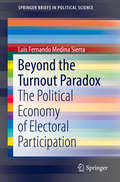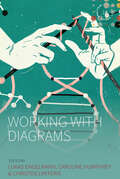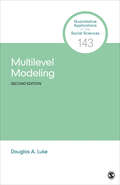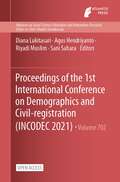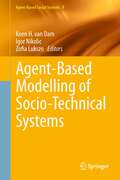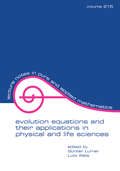- Table View
- List View
Extremes and Recurrence in Dynamical Systems
by Valerio Lucarini Ana De Freitas Jorge De Freitas Davide Faranda Mark Holland Matthew Nicol Mike Todd Sandro Vaienti Jeroen WoutersPresents recent advances on the theory of extreme values that result from investigations of dynamical systems applications Written by a team of international experts, Extremes and Recurrence in Dynamical Systems presents a unique point of view on the mathematical theory of extremes and how it relates to applications in the natural and social sciences. Featuring an interdisciplinary approach to new concepts in pure and applied mathematical research, the book skillfully combines the areas of statistical mechanics, probability theory, measure theory, dynamical systems, statistical inference, geophysics, and software application. Emphasizing statistical mechanics, the book introduces robust theoretical embedding for the application of extreme value theory and modeling through dynamical systems. Extremes and Recurrence in Dynamical Systems also features: A careful examination of how a dynamical system can be taken as a generator of stochastic processes Discussions on the applications of statistical inference in the theoretical and heuristic use of extremes Several examples of analysis of extremes in a physical and geophysical context A final summary of the main results presented with a discussion of forthcoming research guidelines An appendix with software Matlab® and Octave programming language to help readers to develop further understanding of the presented concepts Extremes and Recurrence in Dynamical Systems is ideal for academics and practitioners in pure and applied mathematics, probability theory, statistics, chaos, theoretical and applied dynamical systems, statistical mechanics, geophysical fluid dynamics, geosciences and complexity science.
Private Tutor - SAT Math 2013-2014 Prep Course
by Amy LucasThe purchase of this eBook includes an offer for a FREE DVD or Digital Download of 2 hours from our 20-hour SAT prep video course. Private Tutor SAT Math 2013-2014 Prep Course is a critically-praised, low cost alternative to the often unaffordable tutoring industry. Students can achieve the results of private tutoring at a fraction of the cost. This complete course covers all aspects of the SAT Math sections including numerous practice drills with detailed answer explanations. Written by Amy Lucas, a Summa Cum Laude graduate of UCLA with fifteen years of experience as an SAT Master Tutor and Education Specialist. The School Library Journal Starred Review stated "Library collections serving high school students as well as homeschoolers seeking instruction, practice, and basic standardized test-taking tips for the Math SAT will find this series an essential purchase." The Library Journal stated, " Verdict: highly recommended for students taking the SATs." Math book can be used alone or with the corresponding 10-hour DVD course. * Achieve the results of Private Tutoring at a fraction of the cost! * SAT Math Vocabulary from Integers to Modes * Narrowing down Answer Choices faster * Includes everything from Arithmetic & Algebra to 3D Figures & Coordinate Geometry * Practice drills with Answers and Explanations * Personal one-to-one approach from an experienced Master Tutor INCLUDES: * Math Vocabulary * Basic Plugging * Must Be/Could Be Problems * Answer Choice Test (A.C.T.) * Sneaky Plug-in * Arithmetic Lesson * Algebra Lesson * Geometry Lesson * Functions Lesson * Drills and Answer Explanations
World Inequality Report 2022
by Lucas Chancel, Thomas Piketty, Emmanuel Saez and Gabriel ZucmanProduced by a team of world-leading economists, this is the benchmark account of recent and historical trends in inequality.World Inequality Report 2022 is the most authoritative and comprehensive account available of global trends in inequality. Researched, compiled, and written by a team of world-leading economists, the report builds on the pioneering edition of 2018 to provide policy makers and scholars everywhere up-to-date information about an ever broader range of countries and about forms of inequality that researchers have previously ignored or found hard to trace.Over the past decade, inequality has taken center stage in public debate as the wealthiest people in most parts of the world have seen their share of the economy soar relative to that of others. The resulting political and social pressures have posed harsh new challenges for governments and created a pressing demand for reliable data. The World Inequality Lab, housed at the Paris School of Economics and the University of California, Berkeley, has answered this call by coordinating research into the latest trends in the accumulation and distribution of income and wealth on every continent. This new report not only extends the lab’s international reach but provides crucial new information about the history of inequality, gender inequality, environmental inequalities, and trends in international tax reform and redistribution.World Inequality Report 2022 will be a key document for anyone concerned about one of the most imperative and contentious subjects in contemporary politics and economics.
Individual Choice Behavior: A Theoretical Analysis (Dover Books on Mathematics)
by R. Duncan LuceThis influential treatise presents upper-level undergraduates and graduate students with a mathematical analysis of choice behavior. It begins with the statement of a general axiom upon which the rest of the book rests; the following three chapters, which may be read independently of each other, are devoted to applications of the theory to substantive problems: psychophysics, utility, and learning.Applications to psychophysics include considerations of time- and space-order effects, the Fechnerian assumption, the power law and its relation to discrimination data, interaction of continua, discriminal processes, signal detectability theory, and ranking of stimuli. The next major theme, utility theory, features unusual results that suggest an experiment to test the theory. The final chapters explore learning-related topics, analyzing the stochastic theories of learning as the basic approach—with the exception that distributions of response strengths are assumed to be transformed rather than response probabilities. The author arrives at three classes of learning operators, both linear and nonlinear, and the text concludes with a useful series of appendixes.
California Algebra 1: Concepts, Skills, and Problem Solving
by Beatrice Luchin Gilbert J. Cuevas Berchie HollidayNIMAC-sourced textbook
Teaching Mathematics to English Language Learners: Preparing Pre-service and In-service Teachers (English Language Education Ser. #17)
by Luciana C. de Oliveira Marta CivilThis edited book is about preparing pre-service and in-service teachers to teach secondary-level mathematics to English Language Learners (ELLs) in twenty-first century classrooms. Chapter topics are grounded in both research and practice, addressing a range of timely topics including the current state of ELL education in the secondary mathematics classroom, approaches to leveraging the talents and strengths of bilingual students in heterogeneous classrooms, best practices in teaching mathematics to multilingual students, and ways to infuse the secondary mathematics teacher preparation curriculum with ELL pedagogy. This book will appeal to all teachers of ELLs, teacher educators and researchers of language acquisition more broadly. This volume is part of a set of four edited books focused on teaching the key content areas to English language learners. The other books in the set focus on teaching History and Social Studies, English Language Arts, and Science to ELLs.
AI for School Teachers (AI for Everything)
by Rose Luckin Karine George Mutlu CukurovaWhat is artificial intelligence? Can I realistically use it in my school? What’s best done by human intelligence vs. artificial intelligence, and how do I bring these strengths together? What would it look like for me, and my school, to be AI Ready? AI for School Teachers will help teachers and headteachers understand enough about AI to build a strategy for how it can be used in their school. Examining the needs of schools to ensure they are ready to leverage the power of AI and drawing examples from early years to high school students, this book outlines the educational implications and benefits that AI brings to school education in practical ways. It develops an understanding of what AI is and isn't and how we define and measure what we value and provides a framework which supports a step-by-step approach to developing an AI mindset, focusing on ways to improve educational opportunities for students with evidence-informed interventions.
Classical Financial Mathematics: Basic Ideas, Central Formulas and Terms at a Glance (essentials)
by Bernd LudererThis essential teaches basic formulas, methods and ideas of classical financial mathematics. Since classical financial mathematics makes do with elementary mathematical tools, any interested reader with average mathematical school knowledge can easily follow this text. The core of the text is the calculation of interest and compound interest, annuity calculation, amortization calculation and price calculation. A large number of practical examples illustrate the mathematical questions.This Springer essential is a translation of the original German 1st edition essentials, Klassische Finanzmathematik by Bernd Luderer, published by Springer Fachmedien Wiesbaden GmbH, part of Springer Nature in 2019. The translation was done with the help of artificial intelligence (machine translation by the service DeepL.com). A subsequent human revision was done primarily in terms of content, so that the book will read stylistically differently from a conventional translation. Springer Nature works continuously to further the development of tools for the production of books and on the related technologies to support the authors.
Formeln und Begriffe der Analysis: Für Studierende der Ingenieurwissenschaften (essentials)
by Bernd LudererDie wichtigsten mathematischen Formeln und Begriffe aus dem Gebiet Analysis für Studierende der Ingenieurwissenschaften und verwandter Richtungen werden präsentiert. Dieses essential ist nützlich als Ergänzung zum Studium, beim Selbststudium, als Nachschlagewerk zum täglichen Gebrauch und in der Klausur. Enthalten ist in übersichtlicher Weise alles Wichtige zu komplexen Zahlen, Definition und Eigenschaften zahlreicher Funktionen, Differenzial- und Integralrechnung, einschließlich Doppel- und Dreifachintegrale, sowie gewöhnlichen Differenzialgleichungen.
Klassische Finanzmathematik: Grundideen, zentrale Formeln und Begriffe im Überblick (essentials)
by Bernd LudererDieses essential vermittelt grundlegende Formeln, Methoden und Ideen der klassischen Finanzmathematik. Da die klassische Finanzmathematik mit elementaren mathematischen Hilfsmitteln auskommt, kann jede/r interessierte Leser/in mit durchschnittlichen mathematischen Schulkenntnissen diesem Text gut folgen. Das Kernstück bilden Zins- und Zinseszinsrechnung, Rentenrechnung, Tilgungsrechnung und Kursrechnung. Eine größere Zahl praktischer Beispiele veranschaulicht die mathematischen Fragestellungen.
Einstieg in die Wirtschaftsmathematik (Studienbücher Wirtschaftsmathematik)
by Bernd Luderer Uwe WürkerMathematische Methoden sind integraler Bestandteil der verschiedensten wirtschaftswissenschaftlichen Gebiete. Eine sichere Beherrschung der allgemeinen mathematischen Grundlagen sowie der wichtigsten Begriffe und Ideen aus Analysis, Linearer Algebra, Linearer Optimierung und Finanzmathematik sind deshalb für Sozial- und Wirtschaftswissenschaftler unabdingbar. Der Vermittlung dieser Kenntnisse dient das vorliegende Buch, in dem besonderer Wert auf eine verständliche Darlegung sowie zahlreiche Anwendungsbeispiele und Übungsaufgaben mit wirtschaftswissenschaftlichem Bezug gelegt wird.
Boundaries of a Complex World (Springer Series in Synergetics)
by Andrei LuduThe centraltheme of this book is the extent to which the structure of the free dynamicalboundaries of a system controls the evolution of the system as a whole. Applyingthree orthogonal types of thinking - mathematical, constructivist andmorphological, it illustrates these concepts using applications to selectedproblems from the social and life sciences, as well as economics. In a broadercontext, it introduces and reviews some modern mathematical approaches to thescience of complex systems. Standard modeling approaches (based on non-lineardifferential equations, dynamic systems, graph theory, cellular automata,stochastic processes, or information theory) are suitable for studying localproblems. However they cannot simultaneously take into account all the differentfacets and phenomena of a complex system, and new approaches are required to solvethe challenging problem of correlations between phenomena at different levelsand hierarchies, their self-organization and memory-evolutive aspects, the growthof additional structures and are ultimately required to explain why and howsuch complex systems can display both robustness and flexibility. This graduate-leveltext also addresses a broader interdisciplinary audience, keeping themathematical level essentially uniform throughout the book, and involving onlybasic elements from calculus, algebra, geometry and systems theory.
Boundaries of a Complex World (Springer Series in Synergetics)
by Andrei LuduThe 2nd edition of this book provides novel topics and studyies in boundaries of networks and Big Data Systems.The central theme of this book is the extent to which the structure of the free dynamical boundaries of a system controls the evolution of the system as a whole. Applying three orthogonal types of thinking - mathematical, constructivist and morphological, it illustrates these concepts using applications to selected problems from the social and life sciences, as well as economics. In a broader context, it introduces and reviews some modern mathematical approaches to the science of complex systems. Standard modeling approaches (based on non-linear differential equations, dynamic systems, graph theory, cellular automata, stochastic processes, or information theory) are suitable for studying local problems. However they cannot simultaneously take into account all the different facets and phenomena of a complex system, and new approaches are required to solve the challenging problem of correlations between phenomena at different levels and hierarchies, their self-organization and memory-evolutive aspects, the growth of additional structures and are ultimately required to explain why and how such complex systems can display both robustness and flexibility. This graduate-level text addresses a broader interdisciplinary audience, keeping the mathematical level essentially uniform throughout the book, and involving only basic elements from calculus, algebra, geometry and systems theory.
Nonlinear Waves and Solitons on Contours and Closed Surfaces
by Andrei LuduThis volume is an introduction to nonlinear waves and soliton theory in the special environment of compact spaces such a closed curves and surfaces and other domain contours. It assumes familiarity with basic soliton theory and nonlinear dynamical systems. The first part of the book introduces the mathematical concept required for treating the manifolds considered, providing relevant notions from topology and differential geometry. An introduction to the theory of motion of curves and surfaces - as part of the emerging field of contour dynamics - is given. The second and third parts discuss the modeling of various physical solitons on compact systems, such as filaments, loops and drops made of almost incompressible materials thereby intersecting with a large number of physical disciplines from hydrodynamics to compact object astrophysics. This book is intended for graduate students and researchers in mathematics, physics and engineering. This new edition has been thoroughly revised, expanded and updated.
Einstein in Matrix Form: Exact Derivation of the Theory of Special and General Relativity without Tensors
by Günter LudykThis book is an introduction to the theories of Special and General Relativity. The target audience are physicists, engineers and applied scientists who are looking for an understandable introduction to the topic - without too much new mathematics. The fundamental equations of Einstein's theory of Special and General Relativity are derived using matrix calculus, without the help of tensors. This feature makes the book special and a valuable tool for scientists and engineers with no experience in the field of tensor calculus. In part I the foundations of Special Relativity are developed, part II describes the structure and principle of General Relativity. Part III explains the Schwarzschild solution of spherical body gravity and examines the "Black Hole" phenomenon. Any necessary mathematical tools are user friendly provided, either directly in the text or in the appendices.
Linear and Nonlinear Programming
by David G. Luenberger Yinyu YeThis new edition covers the central concepts of practical optimization techniques, with an emphasis on methods that are both state-of-the-art and popular. One major insight is the connection between the purely analytical character of an optimization problem and the behavior of algorithms used to solve a problem. This was a major theme of the first edition of this book and the fourth edition expands and further illustrates this relationship. As in the earlier editions, the material in this fourth edition is organized into three separate parts. Part I is a self-contained introduction to linear programming. The presentation in this part is fairly conventional, covering the main elements of the underlying theory of linear programming, many of the most effective numerical algorithms, and many of its important special applications. Part II, which is independent of Part I, covers the theory of unconstrained optimization, including both derivations of the appropriate optimality conditions and an introduction to basic algorithms. This part of the book explores the general properties of algorithms and defines various notions of convergence. Part III extends the concepts developed in the second part to constrained optimization problems. Except for a few isolated sections, this part is also independent of Part I. It is possible to go directly into Parts II and III omitting Part I, and, in fact, the book has been used in this way in many universities. New to this edition is a chapter devoted to Conic Linear Programming, a powerful generalization of Linear Programming. Indeed, many conic structures are possible and useful in a variety of applications. It must be recognized, however, that conic linear programming is an advanced topic, requiring special study. Another important topic is an accelerated steepest descent method that exhibits superior convergence properties, and for this reason, has become quite popular. The proof of the convergence property for both standard and accelerated steepest descent methods are presented in Chapter 8. As in previous editions, end-of-chapter exercises appear for all chapters. From the reviews of the Third Edition: ". . . this very well-written book is a classic textbook in Optimization. It should be present in the bookcase of each student, researcher, and specialist from the host of disciplines from which practical optimization applications are drawn. " (Jean-Jacques Strodiot, Zentralblatt MATH, Vol. 1207, 2011)
Vehicle Dynamics of Modern Passenger Cars (CISM International Centre for Mechanical Sciences #582)
by Peter LugnerThe book provides the essential features necessary to understand and apply the mathematical-mechanical characteristics and tools for vehicle dynamics including control mechanism. An introduction to passenger car modeling of different complexities provides the basics for the dynamical behavior and presents vehicle models later used for the application of control strategies. The presented modeling of the tire behavior, also for transient changes of the contact patch properties, shows the necessary mathematical descriptions used for the simulation of the vehicle dynamics. The introduction to control for cars and its extension to complex applications using e.g. observers and state estimators is a main part of the book. Finally the formulation of proper multibody codes for the simulation leads to the integration of all parts. Examples of simulations and corresponding test verifications show the profit of such a theoretical support for the investigation of the dynamics of passenger cars.
The Emerging Quantum
by Luis de la Peña Ana María Cetto Andrea Valdés HernándezThis monograph presents the latest findings from a long-term research project intended to identify the physics behind Quantum Mechanics. A fundamental theory for quantum mechanics is constructed from first physical principles, revealing quantization as an emergent phenomenon arising from a deeper stochastic process. As such, it offers the vibrant community working on the foundations of quantum mechanics an alternative contribution open to discussion. The book starts with a critical summary of the main conceptual problems that still beset quantum mechanics. The basic consideration is then introduced that any material system is an open system in permanent contact with the random zero-point radiation field, with which it may reach a state of equilibrium. Working from this basis, a comprehensive and self-consistent theoretical framework is then developed. The pillars of the quantum-mechanical formalism are derived, as well as the radiative corrections of nonrelativistic QED, while revealing the underlying physical mechanisms. The genesis of some of the central features of quantum theory is elucidated, such as atomic stability, the spin of the electron, quantum fluctuations, quantum nonlocality and entanglement. The theory developed here reaffirms fundamental scientific principles such as realism, causality, locality and objectivity.
Beyond the Turnout Paradox
by Luis Fernando Medina SierraThis Brief uses game-theoretic analysis to debunk the turnout paradox and offers an alternative economic model to elucidate the patterns behind the socioeconomic bias in turnout. The author argues that the turnout paradox—the idea that rational, strategic actors would not vote in an election—is an overstated problem, and that, contrary to widespread belief, game-theoretic models of elections with highly realistic parameters are compatible with high turnout. The author applies the method of stability sets to the study of voting games so as to characterize the behavior of electoral turnout in response to the game’s structural parameters. To illustrate the power and potential of this framework, the author then develops a politico-economic model that generates testable theories about the way in which the modern welfare state and redistribution of wealth can shape the patterns of biased turnout that exist in most democracies. By turning a classic problem of rational choice into a source of new methods of analysis this Brief allows game theory to intervene in relevant conversations about the political economy of electoral participation, creating an opportunity for formal methods to make a welcome contribution to the discipline. As such, this Brief will be of use to scholars and student of political science, economics, political economy, and public policy, especially those who work in the tradition of formal methods.
Working With Diagrams (Studies in Social Analysis #14)
by Lukas Engelmann, Caroline Humphrey Christos LynterisArising from the need to go beyond the semiotic, cognitive, epistemic and symbolic reading of diagrams, this book looks at what diagrams are capable of in scholarly work related to the social sciences. Rather than attempting to define what diagrams are, and what their dietic capacity might be, contributions to this volume draw together the work diagrams do in the development of theories. Across a range of disciplines, the chapters introduce the ephemeral dimensions of scientist’s interactions and collaboration with diagrams, consider how diagrams configure cooperation across disciplines, and explore how diagrams have been made to work in ways that point beyond simplification, clarification and formalization.
Multilevel Modeling (Quantitative Applications in the Social Sciences #143)
by Dr. Douglas A. LukeMultilevel Modeling is a concise, practical guide to building models for multilevel and longitudinal data. Author Douglas A. Luke begins by providing a rationale for multilevel models; outlines the basic approach to estimating and evaluating a two-level model; discusses the major extensions to mixed-effects models; and provides advice for where to go for instruction in more advanced techniques. Rich with examples, the Second Edition expands coverage of longitudinal methods, diagnostic procedures, models of counts (Poisson), power analysis, cross-classified models, and adds a new section added on presenting modeling results. A website for the book includes the data and the statistical code (both R and Stata) used for all of the presented analyses.
Multilevel Modeling (Quantitative Applications in the Social Sciences #143)
by Dr. Douglas A. LukeMultilevel Modeling is a concise, practical guide to building models for multilevel and longitudinal data. Author Douglas A. Luke begins by providing a rationale for multilevel models; outlines the basic approach to estimating and evaluating a two-level model; discusses the major extensions to mixed-effects models; and provides advice for where to go for instruction in more advanced techniques. Rich with examples, the Second Edition expands coverage of longitudinal methods, diagnostic procedures, models of counts (Poisson), power analysis, cross-classified models, and adds a new section added on presenting modeling results. A website for the book includes the data and the statistical code (both R and Stata) used for all of the presented analyses.
Proceedings of the 1st International Conference on Demographics and Civil-registration (Advances in Social Science, Education and Humanities Research #702)
by Diana Lukitasari Agus Hendriyanto Riyadi Muslim Sani SaharaThis is an open access book.Massive development of the internet in the current era of openness delivers enormous benefits for easy access to information for both individual users, groups and governments. However on the other hand, this development has also resulted in various types of challenges with certain consequences, one of the challenges is guaranteeing the security of access to personal data. The important role of personal data is to complete individual rights, such as in obtaining social security, banking services, conducting general elections and others, as in this case the presence of the state in participating in ensuring the confidentiality of personal data is very necessary. The State through the 1945 Constitution of the Republic of Indonesia in Article 28G clearly stipulates “every person has the right on protection for his/herself, family, honor, dignity, and property of objects that under his/her power, and entitled on a sense of safe and protection from the threat of fear to do or not to do something which is a human right”.Along with the development of information through the internet, technology continues to find various applications and various variations of new technology. Technological growth is directly align to development growth and impulsively drives population movement. As the object and subject of development, the population is recognized, identified, sorted and analyzed as the development policies implemented capable to be targeted. Population data and information thus occupy a very strategic position. Through Law Number 52 of 2009 on the Population Development and Family Development, the central government and local one are given the mandate to collect, process and present data and information on population and family. These efforts can be done through censuses, surveys and family data collection.One of the developed and applied technologies is the development of Big Data technology. Big Data technology utilized to improve public services provided by the government. The development of this technology consistently utilized to build a complete and centralized database in a single identity. In its implementation, the government has opportunities and challenges to take advantage of this technology. Some of the challenges are related to data security and the community’s perspective on managing their population data. Therefore, it is necessary to conduct a more in-depth study of the application of this technology from various scientific sides to address the opportunities and challenges, especially regarding the security of population data and the behavior of the society towards the guarantee of population data which is managed in the current era of openness.Based on the background above, the D-4 Demographic and Civil Registration Study Program, Sebelas Maret University, Surakarta Vocational School will hosting an Online International Seminar on Demography and Civil Registration with main theme: “Challenges on Population Data Security, Demographic Behavior and Transformation in the Openness Era”.
Agent-Based Modelling of Socio-Technical Systems (Agent-Based Social Systems #9)
by Zofia Lukszo Koen H. Dam Igor NikolicDecision makers in large scale interconnected network systems require simulation models for decision support. The behaviour of these systems is determined by many actors, situated in a dynamic, multi-actor, multi-objective and multi-level environment. How can such systems be modelled and how can the socio-technical complexity be captured? Agent-based modelling is a proven approach to handle this challenge. This book provides a practical introduction to agent-based modelling of socio-technical systems, based on a methodology that has been developed at TU Delft and which has been deployed in a large number of case studies. The book consists of two parts: the first presents the background, theory and methodology as well as practical guidelines and procedures for building models. In the second part this theory is applied to a number of case studies, where for each model the development steps are presented extensively, preparing the reader for creating own models.
Evolution Equations and Their Applications in Physical and Life Sciences: Proceedings Of The Bad Herrenalb (karlsruhe), Germany, Conference (Lecture Notes in Pure and Applied Mathematics)
by G LumerThis volume presents a collection of lectures on linear partial differntial equations and semigroups, nonlinear equations, stochastic evolutionary processes, and evolution problems from physics, engineering and mathematical biology. The contributions come from the 6th International Conference on Evolution Equations and Their Applications in Physica
